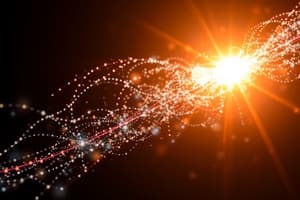Podcast
Questions and Answers
What phenomenon describes the ability of light to exhibit both particle and wave characteristics?
What phenomenon describes the ability of light to exhibit both particle and wave characteristics?
- Energy quantization
- Quantum entanglement
- Particle wave duality (correct)
- Wave interference
Which statement is true regarding the creation and destruction of photons?
Which statement is true regarding the creation and destruction of photons?
- Photons exist only in the visible spectrum.
- Photons can be split into smaller particles.
- Photons can be created or destroyed under certain conditions. (correct)
- Photons cannot be destroyed once created.
What relationship exists between frequency and wavelength of electromagnetic waves?
What relationship exists between frequency and wavelength of electromagnetic waves?
- Equally proportional
- Unrelated
- Inversely proportional (correct)
- Directly proportional
What process involves energy being emitted as photons when electrons transition between energy states?
What process involves energy being emitted as photons when electrons transition between energy states?
Which of the following terms is associated with light emitted from living organisms?
Which of the following terms is associated with light emitted from living organisms?
What occurs when electrons transition from a high energy state to a low energy state?
What occurs when electrons transition from a high energy state to a low energy state?
Which relationship accurately describes frequency and wavelength in electromagnetic waves?
Which relationship accurately describes frequency and wavelength in electromagnetic waves?
Which of the following describes a characteristic of photons?
Which of the following describes a characteristic of photons?
Which phenomenon is primarily associated with light emitted due to electric discharge?
Which phenomenon is primarily associated with light emitted due to electric discharge?
What type of light emission involves living organisms?
What type of light emission involves living organisms?
Flashcards are hidden until you start studying
Study Notes
Particle Wave Duality
- Describes the dual nature of light and matter, exhibiting both particle and wave-like properties.
- Central concept in quantum mechanics, responsible for phenomena like interference and diffraction.
Energy Quantization
- Energy is quantized, meaning it exists in discrete units, corresponding to photons.
- Photons are the fundamental particles of light and carry energy.
Photon
- A photon is the basic unit of light and electromagnetic radiation.
- They can be created and destroyed, aligning with the principles of quantum mechanics.
Electromagnetic Spectrum
- The electromagnetic spectrum includes all types of electromagnetic radiation, from radio waves to gamma rays.
- Each type of radiation has a specific frequency and wavelength.
Frequency and Wavelength
- Frequency refers to the number of waves that pass a point per second, measured in hertz (Hz).
- Wavelength is the distance between successive crests of a wave, inversely proportional to frequency.
Visible Light
- Visible light is the portion of the electromagnetic spectrum that can be seen by the human eye.
- It is a small segment between ultraviolet and infrared radiation.
Incandescence and Phosphorescence
- Incandescence is light produced by high temperatures, where objects emit light due to thermal energy.
- Phosphorescence involves materials absorbing light and re-emitting it over time.
Electric Discharge
- Electric discharge refers to the release of electric energy, often observed in phenomena like lightning or neon lights.
Bioluminescence
- Bioluminescence is a natural phenomenon where living organisms produce light through chemical reactions.
- Examples include fireflies and certain deep-sea organisms.
Luminous Objects
- Luminous objects emit their own light, distinct from those that only reflect light.
- Examples include stars and incandescent bulbs.
Energy Emission from Electrons
- When electrons transition from a high energy state to a low energy state, energy is emitted in the form of photons.
- This energy release is fundamental in processes like fluorescence and radiation.
Particle Wave Duality
- Describes the dual nature of light and matter, exhibiting both particle and wave-like properties.
- Central concept in quantum mechanics, responsible for phenomena like interference and diffraction.
Energy Quantization
- Energy is quantized, meaning it exists in discrete units, corresponding to photons.
- Photons are the fundamental particles of light and carry energy.
Photon
- A photon is the basic unit of light and electromagnetic radiation.
- They can be created and destroyed, aligning with the principles of quantum mechanics.
Electromagnetic Spectrum
- The electromagnetic spectrum includes all types of electromagnetic radiation, from radio waves to gamma rays.
- Each type of radiation has a specific frequency and wavelength.
Frequency and Wavelength
- Frequency refers to the number of waves that pass a point per second, measured in hertz (Hz).
- Wavelength is the distance between successive crests of a wave, inversely proportional to frequency.
Visible Light
- Visible light is the portion of the electromagnetic spectrum that can be seen by the human eye.
- It is a small segment between ultraviolet and infrared radiation.
Incandescence and Phosphorescence
- Incandescence is light produced by high temperatures, where objects emit light due to thermal energy.
- Phosphorescence involves materials absorbing light and re-emitting it over time.
Electric Discharge
- Electric discharge refers to the release of electric energy, often observed in phenomena like lightning or neon lights.
Bioluminescence
- Bioluminescence is a natural phenomenon where living organisms produce light through chemical reactions.
- Examples include fireflies and certain deep-sea organisms.
Luminous Objects
- Luminous objects emit their own light, distinct from those that only reflect light.
- Examples include stars and incandescent bulbs.
Energy Emission from Electrons
- When electrons transition from a high energy state to a low energy state, energy is emitted in the form of photons.
- This energy release is fundamental in processes like fluorescence and radiation.
Studying That Suits You
Use AI to generate personalized quizzes and flashcards to suit your learning preferences.




